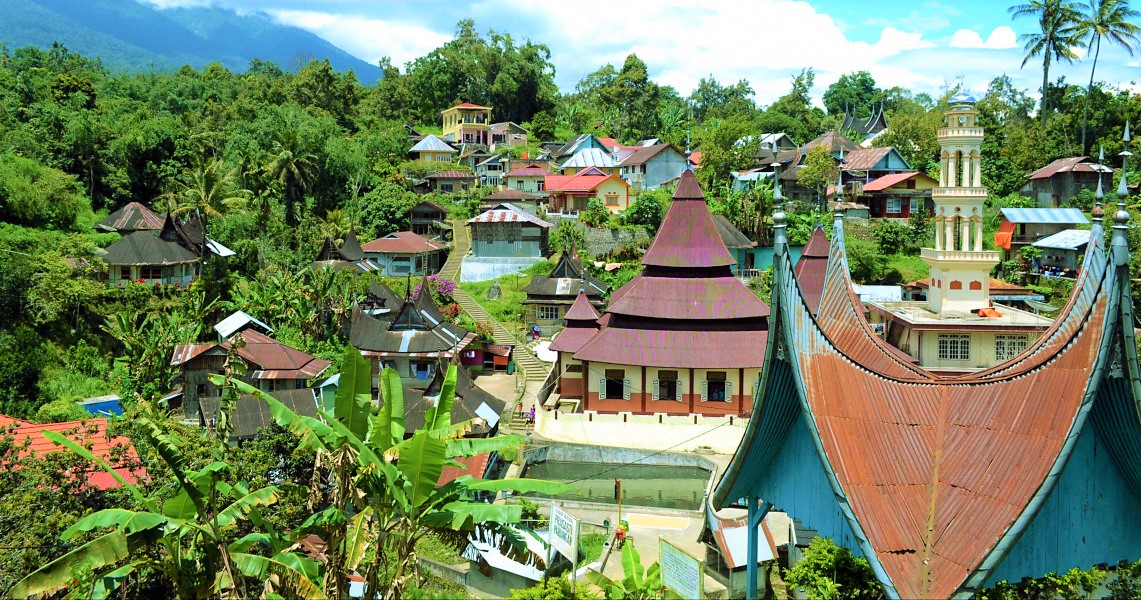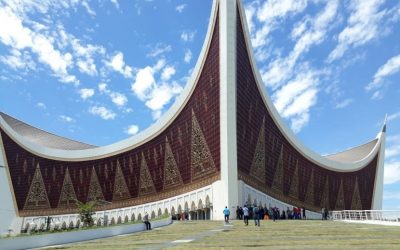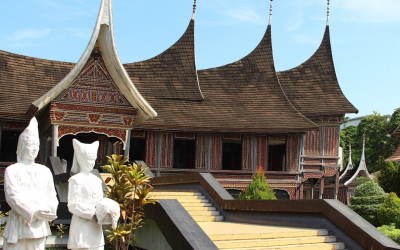Home / Batik Regions – Western Indonesia – Northern Sumatra – West Sumatra / Pariangan Cultural Village
Cultural Destination
Embrace the spirit of the place!
Pariangan Cultural Village

The Pariangan Cultural Village (photo: Pesona Indonesia)
Pariangan Cultural Village
Nagari Pariangan has been declared as the most beautiful village in the world, according to Travel Budget, a tourism media based in New York, USA. This village has a beautiful natural and cultural landscape of an ancient Minangkabau village. This village was blessed with traditional community-based management which is able to preserve the common characteristics and cultural identity of West Sumatra. This place is also well-known as one of the most-favourite destinations during the annual international bicycle racing event, Tour de Singkarak. Nagari Pariangan can be reached in about three hours from Padang, the capital city of West Sumatra Province.
Tourist Attractions in West Sumatra
West Sumatra Grand Mosque
The Great Mosque of West Sumatra is characterized with its Minang-styled air ventilations to
Museum of Adityawarman
The museum was built to commemorate Adityawarman, a king of Minangkabau in
West Sumatra
Batik Motifs
Tanah Liek
The word “Tanah Liek” refers to clay in Minang language. It is also known as
Rangkiang
The word “Rangkiang” refers to the rice granary in the Minangkabau language. It symbolizes
Keluak Daun Pakis
The word “Keluak” is a Minang language which means twisted or tangled. The Motif of
Discover
Indonesian
Batik
Motifs
Daun Simpor
This motif is inspired by the Simpor plant (Dillenia Suffruticosa) which is a typical
Sekomandi
Its philosophical meaning is the eternal union which refers to a saying “until death do us part”
Gonggong Beruntun
This motif illustrates that a person should maintain a positive attitude and
Lok Baintan Floating Market
As you can imagine, the most authentic thing is that you can buy things and even
Burung Bidadari
Bidadari birds are endemic birds in Halmahera. This motif represents an
Sero Tangga
The Sero Tangga illustrates an endearing feeling and sacrifices of a person to fulfil
Kaganga Tanah Rejang
If Batik Besurek combines Arabic calligraphy motifs, then the Kaganga batik takes
Pattimura
Pattimura is the name of an Indonesian hero who fought against colonialism in
Gurdo Solo
Gurdo or garuda bird is the mount of the Indian god Vishnu. As the Sun Bird,
Jupri Kembang Teh
Kembang Teh illustrates the tendrils of tea plants that grow in the highlands of
Daun Lada Hitam
The black pepper motif represents the main commodity of Bangka Belitung
Keluak Daun Pakis
The word “Keluak” is a Minang language which means twisted or tangled. The Motif of
Karawo Pinang
Pinang refers to the Palm areca tree. This motif is considered as the original
Pinawetengan
The Pinawetengan Batik pattern was taken from a prehistoric inscription in
Parang Seling
Parang Seling or “alternating daggers” is a royal batik motif. It is a feminine variant of
Honai
The Honai is inspired by the traditional house of the Papuan community living in
Mahkota Siger
Siger is the crown of a noblewoman in ancient time. It is a symbol of femininity, strength, and
Ikan tambal
The word “Ikan” refers to fish. The philosophical meaning of Ikan Tambal means is
Sekar Jati
Sekar means flower and Jati refers to teak trees that symbolizes a strong mental character that
Taiganja
Taiganja is a precious gold pendant that shows the social status of the Kaili family. It is
Kerawang Tegak Aceh
The Vertical Upright (Kerawang Tegak) Motif symbolizes a person who has a strong
Gamolan
This motif illustrates Gamolan, a bamboo musical instrument of Lampung that is
Bultiya
The word ‘Bultiya’ is an acronym of the three major tribes in North Kalimantan, namely
Singayaksa
The Singayaksa motif comes from the name of a place where Sultan Hasanuddin used to
Paqbarre Allo
The word “Barre” means round and “Allo” means the sunlight. This motif is interpreted as
Gajah Way Kambas
The motif illustrates the Lampung’s natural reserve, the Way Kambas. it also symbolizes
Lipaq Sabe
Lipaq Saqbe contains a simple geometric classical motif with various flower decorations. This textile is
Hiu Taliyasan
Indonesia is also home to the world’s largest fish, the whale shark (Rhincodon typus). Hiu Taliyasan refers to
Pucuk Rebung Riau
Pucuk Rebung symbolizes heart determination in achieving goals, good luck, and
Daun Sirih
This motif illustrates betel leaves that are used by Lombok communities as traditional
Tangerang Herang
Tangerang Herang motif is a symbol of Tangerang city. The Tangerang Herang batik motif consists of
Teguh Bersatu
This batik motif shows the strength of the people of Kupang. It also represents a sense of
Desa Na Tolu
The Desa Na Tolu characteristic pattern symbolizes the Batak philosophy of existence and
Tenun Bima
The motifs are adopted from Bima woven textile. This pattern has received a great
Prada Papua
The word “Prada” in the Javanese-Indonesian dialect means a batik textile that
Ake Patra
Ake is related to the divinity and the composition of the universe. It is a symbol of
Manguni Minahasa
Manguni is identified as the symbol of the Minahasa people. Manguni is known as a
Karawo Mahkuta
Mahkuta refers to Gorontalo’s traditional crown. It represents noble characters of
Ukir Sentani
The Ukir motif is a batik motif that is inspired by various traditional Sentani wood carvings
Gentala Arasy
Built as high as 80 meters, the tower also highlights the historical side of
Bale Lumbu
This motif signifies the welfare of the ancient Sasak society. Bale also symbolizes the
Kuda Kupang
Horses symbolize wealth. It contains noble values of virtuous characters that bring
Pati-Pati Pinehiku
It symbolizes the hierarchy in society and the social status of the Mekongga
Raja Ampat
Raja Ampat motif represents the marine life at Raja Ampat archipelago in
Tubo Kelapa
Coconut tree is a symbol of a good character and strong mentality. It illustrates the more success a person, the more
Gumin Tambun
Based on Hindu mythology, this motif symbolizes lucks, abundant wealth, and
Wakatobi
It symbolizes the coastal beauty of the Wakatobi island and the symbol of Patra symbolizes
Bomba Mawar
This motif means sacred love for family, kingdom, and God; It also illustrates
Angsa Duo
According to legend, the Angso duo batik motif is a pair of swans that are believed to have led Princess
Enggang Dayak
Local people beliefs that hornbills are an incarnation of the Commander of the Birds. It has supernatural
Leuit Sijimat
This motif reflects the daily activities of the Baduy tribe in Banten. The main ornaments of batik motif consist of:
Gorga Simeol-Meol
The Gorga Simeol-meol is a pattern of plant tendrils. it is regarded as a symbol of longevity and
Bintik Tujuh
The Bintik Tujuh (Seven Dots) motif has 7 white spots and green color gradation as
Rangkiang
The word “Rangkiang” refers to the rice granary in the Minangkabau language. It symbolizes
Srimanganti
The name of the Srimanganti motif is derived from Palace’s hallway that connects to
Gonggong Siput
Gonggong (Strombus Turturella) is one type of sea snail found around
Salakanagara
Salakanagara batik motif illustrates the first kingdom in the Betawi land
Besurek Rembulan
This batik illustrates praise for God who created the wonderful universe
Insang Ikan
Insang refers to the gills of the fish. This is a typical pattern of Malay ethnic who inhabits
Tampuk Manggis Sasirangan
The motif illustrates the philosophy of the mangosteen fruit, which is
Buketan Bali
The Balinese bouquet (Buketan Bali) is a floral arrangement and the name is
Dayak Taghol
Dayak Taghol has a distinctive style of four curved lines and small dots. This motif represents
Durian Pecah
Broken Durian motifs depict the foundation of faith. The second half signifies the mastery of
Tifa Totobuang
The batik motifs illustrate Maluku’s traditional music instrument called
Tongkonan
Toraja’s traditional house is called Tongkonan. Tongkonan is a place for
Kasih Tak Sampai
‘Kasih Tak Sampai’ is an idiom in the Indonesian language which refers to
Gedhog Kembang Waluh
a combination of Javanese cultural motif of the Majapahit kingdom (XII-XIV century) with
Kain Cual
Cual textile tradition has existed since the 17th century. The word “Cual” refers to


